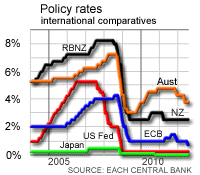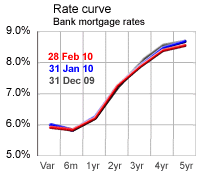 Economists expect the Reserve Bank of New Zealand (RBNZ) will drop its 'low till late 2010' expectation for the Official Cash Rate (OCR) at the next rate announcement on Thursday, October 29, as markets increasingly predict rate hikes in the first half of next year. However, the OCR is widely expected to be kept on hold next week at its record low of 2.5%. Higher than expected inflation figures in the September quarter and jumps in both consumer and business confidence since September have markets pricing in a hike in the OCR as early as January. An official rate hike by the Reserve Bank of Australia earlier this month also sent markets the message that the RBNZ may raise rates earlier than indicated. Export and industry groups have been calling on the RBNZ to cut the OCR further or at least keep it at its current level for fear the New Zealand dollar will rise if the OCR is raised. However, RBNZ Governor Alan Bollard this week said there was not much the central bank could do to control the currency, Businesswire reported:
Economists expect the Reserve Bank of New Zealand (RBNZ) will drop its 'low till late 2010' expectation for the Official Cash Rate (OCR) at the next rate announcement on Thursday, October 29, as markets increasingly predict rate hikes in the first half of next year. However, the OCR is widely expected to be kept on hold next week at its record low of 2.5%. Higher than expected inflation figures in the September quarter and jumps in both consumer and business confidence since September have markets pricing in a hike in the OCR as early as January. An official rate hike by the Reserve Bank of Australia earlier this month also sent markets the message that the RBNZ may raise rates earlier than indicated. Export and industry groups have been calling on the RBNZ to cut the OCR further or at least keep it at its current level for fear the New Zealand dollar will rise if the OCR is raised. However, RBNZ Governor Alan Bollard this week said there was not much the central bank could do to control the currency, Businesswire reported:
"We don't want to see the New Zealand dollar being put under unnecessary pressure again," Bollard said. "If and when we were to increase rates would you see that impact on New Zealand dollar? No, actually the markets already think quite a long way ahead of where we see monetary policy." He also warned that the bank couldn't intervene without taking longer view to the consequences of its actions. "You shouldn't be short-term overactivist and then regret it in the medium term," he said.
The RBNZ said at the end of April it expected to keep the OCR at or below its current level until the latter part of 2010:
We expect to keep the OCR at or below the current level through until the latter part of 2010. The OCR could still move modestly lower over the coming quarters.
It reiterated this expectation in its June statement, in July and in September.  However, economists think the statement may have done its job and run its course, leading some of them to forecast the RBNZ will drop the phrase. Here is what ASB's economists wrote:
However, economists think the statement may have done its job and run its course, leading some of them to forecast the RBNZ will drop the phrase. Here is what ASB's economists wrote:
The economic outlook has improved considerably over the 6 weeks following the September MPS. The sheer volume of stronger than expected developments will see RBNZ strongly reconsider both the economic outlook and the appropriateness of an OCR at 2.5%. Included in this stronger data are upward revisions to the global outlook, gathering momentum in house price inflation, stronger than expected Q2 GDP, inflation pressures unwinding slower than expected, and very sharp lifts in consumer and business confidence. However, the continued rise in the NZ dollar provides offset to the improvement in domestic demand. We expect the RBNZ to remain on hold at the October OCR review, but drop the statement that it expects "to keep the OCR at or below current levels until the latter part of 2010". Given recent developments, this statement will no longer be seen as credible, its time to rewrite the policy outlook part of the statement. We expect the RBNZ to remain on hold until April 2010, with the view the RBNZ will want to confirm and be confident growth has become sustainable before lifting the cash rate. We expect initial rate hikes to be aggressive (50 basis point steps) to promptly lift the cash rate off emergency settings.
Here is what Westpac's economists had to say:
Our view is that the RBNZ will take some time before acting to remove its stimulus "“ partly because they're not yet fully convinced that the recovery is secure, and partly because they will want to signal a change in tack in a way that doesn't cause the market to react violently. We expect that next Thursday's statement will be the first step along that path, by jettisoning the last vestige of an easing bias and removing the expectation that rates will remain "at or below current levels through until the latter part of 2010". In its stead they will probably have a phrase akin to "the OCR can stay at a low level for a considerable period of time". The end goal is a gradual tightening cycle beginning in Q1 next year.
BNZ economists said Thursday's statement was crucial, with market expectations for the OCR "so far ahead of the RBNZ's own expectations":
(The markets are) fully expecting a first hike in the OCR as early as the January meeting next year, and 200 basis points of hikes over the next twelve months. The next big test for market expectations is, of course, the RBNZ's OCR review, next Thursday. With market pricing so far ahead of the Reserve Bank's own expectations, this is shaping up to be a crucial announcement. The problem for the Reserve Bank is that any sign of wavering from its "lower for longer" mantra, could be seen by an already giddy market as implicit validation of market expectations. On the other hand, to continue to suggest the OCR will remain at its current level (or lower) until the end of 2010 strains credibility, in the markets' collective mind, if nowhere else. For the record, we don't favour either extreme. Instead, our long-held view is something of a happy compromise, of tightening from the middle of next year.
Here is Bernard Hickey's take on what the Reserve Bank might do on Thursday.

We welcome your comments below. If you are not already registered, please register to comment
Remember we welcome robust, respectful and insightful debate. We don't welcome abusive or defamatory comments and will de-register those repeatedly making such comments. Our current comment policy is here.